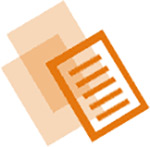
How to Tape the Nose After Rhinoplasty
Taping the nose after a rhinoplasty controls edema (swelling) of the nose. Taping holds light pressure on the skin to prevent the skin and soft tissue of the nose from expanding. In addition, rhinoplasty changes the underlying shape of the nose by altering the shape of the cartilage. Taping allows the skin of the nose to conform to this new shape.
Dr. Shah offers rhinoplasty procedures in Chicago, IL, and nose taping techniques to ensure your desired results! Keep reading to learn more about how to tape the nose after rhinoplasty.
Types of Taping
Dr. Shah utilizes two different types of taping techniques for patients after rhinoplasty.
Taping Methods: Type One
In Type 1, patients place a single strip of tape over the supratip of the nose.
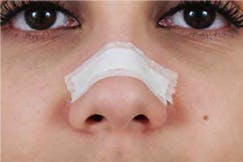
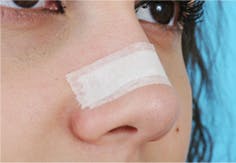
Taping Methods: Type Two
In Type 2, patients place a strip of tape under the columella of the nose and then gently squeeze the tape around the infratip lobule. An additional strip of tape is placed on the supratip of the nose. (See photo and video explanation below)
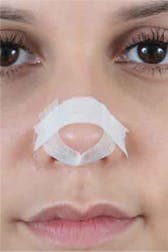
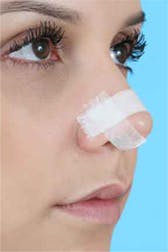
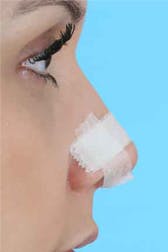
Dr. Shah will recommend a taping method and duration post-procedure.
How To Apply Nasal Tape
Before applying the tape, clean your nose with rubbing alcohol and allow it to dry completely. Cleaning the nose removes any oils that may prevent the tape from sticking.
Step 1) Tape your nasal bridge.
Cut the tape so that it covers the bridge of the nose and extends slightly onto the cheeks. Position the tape over the bridge of the nose and position the tape first without attaching the sides. Pull the tape tight and press it along the sides of the nose and cheeks. Remember, you are trying to compress the skin of the nose to help it attach to the cartilage and bone.
Step 2) Wrap the tip with a “U”
When wrapping the tip of the nose, use a piece of tape about 10 to 12 cm long. The middle of the piece of tape should be directly underneath the tip of the nose. Carefully press the tape up the sides of the nose until the ends rest right beneath the eyes. This type of taping supports the tip of the nose as it heals into its new position.
Step 3) Repeat
Repeat and continue wrapping your nose for as long as your surgeon recommends.
Removal of Tape and Residue
Dr. Shah’s office will provide you with tape post-procedure. Paper tape no wider than half an inch is recommended.
Since the purpose of taping is to help the skin of the nose adhere to the underlying cartilage and bone, you want to make sure to carefully remove the tape without pulling on the skin too much.
One way to keep from pulling the tape is to remove it during a hot shower. Allow the tape to soak and apply plenty of soap to unstick the adhesive. If you are removing the tape outside of the shower, use tweezers to gently lift the edge and pull the tape parallel to the skin’s surface.
Often, the tape will leave residue on the nose after it’s removed. Wash it gently with soap or use a mild astringent to help dissolve the glue from the tape if needed.
Frequently Asked Questions
What are the advantages of taping?
It allows for a nose to take its shape faster than just allowing it to heal on its own. In some cases, it may help prevent the formation of scar tissue on the nose.
What are the disadvantages of taping?
Taping can irritate the nose in some cases. Some patients have difficulty removing the residue from the tape in the morning.
Should I tape my nose all of the time?
Dr. Shah recommends letting the skin of the nose breathe during the day. Taping the nose too much can lead to irritation and cause more swelling in some cases.
How do you know when to stop taping?
If the patient does not note a difference on mornings when he/she tapes or doesn’t tape, then taping is no longer required. Consult with Dr. Shah if you have any questions or concerns about how long you should tape your nose.
When is the best time to tape my nose?
Dr. Shah typically recommends taping the nose during sleep. The majority of swelling occurs during the evening and taping during sleep prevents the nose from swelling in the morning.
How many months do I have to tape my nose?
Only tape your nose if directed by Dr. Shah. Most patients who are instructed to tape their noses do so for 1-3 months after the procedure. However, some patients do tape their noses for longer, depending on individual differences in the soft tissue envelope and healing.


